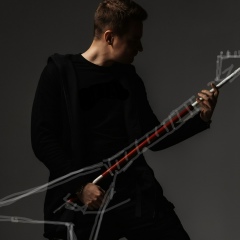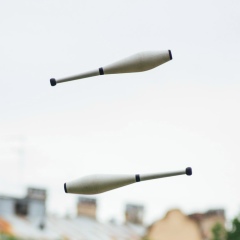Ода о баке из нержавейки
У нас на даче уже пару лет валяется 120-литровый бак из нержавейки, оставшийся от старой бани. Я придумал пристроить его к планируемой железной печке на 2 этаже. Причем пристроить не просто, а как-то так: https://vk.com/photo20561_401267795 Но предварительно надо избавить его от теплообменника и навертеть новых дырок со штуцерами для подключения к печи. Сварщики за эту операцию запросили 8 тыр. Я решил сделать сам, дешевле (ну, это в теории) и интереснее.
Сначала мне стало лень тащить на дачу болгарку, и я решил отрезать теплообменник труборезом. Но труборезы, явно рассчитанные на сталь, у нас стоят, как самолет. Причем требуют еще и специальных роликов. Заказал в итоге труборез в США. Заодно с ним заказал датчики угарного газа, давно хотел.
Пока посылка ехала, думал, что делать с оставшимися обрезками теплообменника. Сначала решил нарезать на них резьбу и навинтить туда заглушки, даже купил плашку с держателем. Потом критически посмотрел на эти трубы еще раз и понял, что без станка ничего у меня не выйдет. Вспомнил, что уже купил круговую пилу для проделывания 27-мм отверстий в баке для установки штуцеров - можно высверлить огрызки целиком, затем заткнуть пробкой и затянуть фланцевой гайкой.
Итак, труборез приехал. Чтобы добить до бесплатной доставки по США, я заказал к нему 2 ролика для резки стали (стандартный в комплекте - для меди). Дома оказалось, что каждый "ролик" - это на самом деле 6 роликов. И куда мне теперь девать эти 11 лишних? Поди, еще мои внуки будут ими трубы резать. Благо, стоили недорого.
Я потренировался на медных трубах дома, приехал на дачу и начал резать теплообменник. Капал масло, все по правилам. Резал долго, даже подумал, что подозрительно как-то. Наконец, одна труба отскочила, принялся за вторую, и вскоре теплообменник отвалился. Сказать, что я офигел от толщины стенок - значит, ничего не сказать. Я думал, они там раза в 2 тоньше (как шток у вилки, например). Размера ролика трубореза могло и не хватить.
Нашел на даче дрель (оказалась дохлой, на 400 Вт), воткнул круговую пилу (выглядит, как сверло, окруженное свернутым в кольцо полотном диаметром 27 мм) и начал по маслу буравить огрызок. Пила рассчитана на 1-мм сталь, а там из-за наплывов сварки было что-то ближе к 5 мм. Долго-долго пилил, дрель ощутимо нагрелась, однако наконец-то первый огрызок выпал. Смотрю - у пилы не хватает четверти зубьев. Мда.
Пока дрель остывала, пошел поколол дрова, пообщался с соседями, сам отдохнул. Вернулся, начал буравить второй огрызок. Но там процесс как-то вяло пошел с самого начала, я срезал наплывы сварки, а дальше что-то не идет. Дал дрели остыть, затем налег на нее, и вскоре из дрели пошел дымок. Видимо, короткие сеансы остывания не помогают, а 400 Вт не хватает для полного счастья. И тут уже полдня прошло, пора бы и домой ехать.
Оставил бак как есть, уехал домой. Мелькала мысль купить новую пилу, но второй раз платить 500 р. не захотелось. Посмотрел, что за дрель дома лежит - 500 Вт, тоже не густо. Но через неделю взял ее с собой, и остаток бака допилил неожиданно быстро! Теперь предстоит зачистить отверстия (особенно от остатков наплывов сварки), закрутить в них пробки с гайками, после чего - уже после установки печи просверлить пару 27-мм отверстий в днище и вкрутить туда штуцеры.
Отдельная эпопея - как установить бак. Для него требовалось найти подставку, которая бы одновременно: а) была абсолютно негорючей (печка рядом), б) была высотой 1 метр, в) выдерживала 120 кг. Отдельный вопрос был с надежностью пола, т.к. сама печь с дымоходом весит в районе 150 кг, плюс еще 120 кг бак рядом - за пол страшно. Выручил папа, подсказавший подвесить бак под стропилами крыши на цепях. Так снимаются все требования к подставке, плюс нагрузка на пол снижается почти в 2 раза. Очевидно, так и буду делать.
Надеюсь, что в конце концов к лету на втором этаже будет свой водопровод! Кстати, дачу рисовал в хорошей бесплатной программе Sweet Home 3D.
У нас на даче уже пару лет валяется 120-литровый бак из нержавейки, оставшийся от старой бани. Я придумал пристроить его к планируемой железной печке на 2 этаже. Причем пристроить не просто, а как-то так: https://vk.com/photo20561_401267795 Но предварительно надо избавить его от теплообменника и навертеть новых дырок со штуцерами для подключения к печи. Сварщики за эту операцию запросили 8 тыр. Я решил сделать сам, дешевле (ну, это в теории) и интереснее.
Сначала мне стало лень тащить на дачу болгарку, и я решил отрезать теплообменник труборезом. Но труборезы, явно рассчитанные на сталь, у нас стоят, как самолет. Причем требуют еще и специальных роликов. Заказал в итоге труборез в США. Заодно с ним заказал датчики угарного газа, давно хотел.
Пока посылка ехала, думал, что делать с оставшимися обрезками теплообменника. Сначала решил нарезать на них резьбу и навинтить туда заглушки, даже купил плашку с держателем. Потом критически посмотрел на эти трубы еще раз и понял, что без станка ничего у меня не выйдет. Вспомнил, что уже купил круговую пилу для проделывания 27-мм отверстий в баке для установки штуцеров - можно высверлить огрызки целиком, затем заткнуть пробкой и затянуть фланцевой гайкой.
Итак, труборез приехал. Чтобы добить до бесплатной доставки по США, я заказал к нему 2 ролика для резки стали (стандартный в комплекте - для меди). Дома оказалось, что каждый "ролик" - это на самом деле 6 роликов. И куда мне теперь девать эти 11 лишних? Поди, еще мои внуки будут ими трубы резать. Благо, стоили недорого.
Я потренировался на медных трубах дома, приехал на дачу и начал резать теплообменник. Капал масло, все по правилам. Резал долго, даже подумал, что подозрительно как-то. Наконец, одна труба отскочила, принялся за вторую, и вскоре теплообменник отвалился. Сказать, что я офигел от толщины стенок - значит, ничего не сказать. Я думал, они там раза в 2 тоньше (как шток у вилки, например). Размера ролика трубореза могло и не хватить.
Нашел на даче дрель (оказалась дохлой, на 400 Вт), воткнул круговую пилу (выглядит, как сверло, окруженное свернутым в кольцо полотном диаметром 27 мм) и начал по маслу буравить огрызок. Пила рассчитана на 1-мм сталь, а там из-за наплывов сварки было что-то ближе к 5 мм. Долго-долго пилил, дрель ощутимо нагрелась, однако наконец-то первый огрызок выпал. Смотрю - у пилы не хватает четверти зубьев. Мда.
Пока дрель остывала, пошел поколол дрова, пообщался с соседями, сам отдохнул. Вернулся, начал буравить второй огрызок. Но там процесс как-то вяло пошел с самого начала, я срезал наплывы сварки, а дальше что-то не идет. Дал дрели остыть, затем налег на нее, и вскоре из дрели пошел дымок. Видимо, короткие сеансы остывания не помогают, а 400 Вт не хватает для полного счастья. И тут уже полдня прошло, пора бы и домой ехать.
Оставил бак как есть, уехал домой. Мелькала мысль купить новую пилу, но второй раз платить 500 р. не захотелось. Посмотрел, что за дрель дома лежит - 500 Вт, тоже не густо. Но через неделю взял ее с собой, и остаток бака допилил неожиданно быстро! Теперь предстоит зачистить отверстия (особенно от остатков наплывов сварки), закрутить в них пробки с гайками, после чего - уже после установки печи просверлить пару 27-мм отверстий в днище и вкрутить туда штуцеры.
Отдельная эпопея - как установить бак. Для него требовалось найти подставку, которая бы одновременно: а) была абсолютно негорючей (печка рядом), б) была высотой 1 метр, в) выдерживала 120 кг. Отдельный вопрос был с надежностью пола, т.к. сама печь с дымоходом весит в районе 150 кг, плюс еще 120 кг бак рядом - за пол страшно. Выручил папа, подсказавший подвесить бак под стропилами крыши на цепях. Так снимаются все требования к подставке, плюс нагрузка на пол снижается почти в 2 раза. Очевидно, так и буду делать.
Надеюсь, что в конце концов к лету на втором этаже будет свой водопровод! Кстати, дачу рисовал в хорошей бесплатной программе Sweet Home 3D.
Ode to stainless steel tank
We have been in the country for a couple of years lying around a 120-liter stainless steel tank left over from the old bath. I came up with an attachment to the planned iron stove on the 2nd floor. And it’s not easy to attach, but something like this: https://vk.com/photo20561_401267795 But first you need to save it from the heat exchanger and screw in new holes with fittings for connecting to the furnace. Welders for this operation requested 8 sput. I decided to do it myself, cheaper (well, that's in theory) and more interesting.
At first, I was too lazy to drag a grinder to the cottage, and I decided to cut off the heat exchanger with a pipe cutter. But the pipe cutters, clearly designed for steel, are standing here like an airplane. Moreover, they also require special clips. As a result, I ordered a pipe cutter in the USA. At the same time I ordered carbon monoxide detectors, I had wanted it for a long time.
While the package was traveling, I thought what to do with the remaining scraps of the heat exchanger. At first I decided to thread them and screw the plugs there, even bought a die with a holder. Then he critically looked at these pipes once more and realized that without a machine, nothing would come of me. I remembered that I had already bought a circular saw for making 27-mm holes in the tank for installing fittings - you can drill the whole bits, then plug it with a stopper and tighten with a flange nut.
So, the pipe cutter has arrived. To finish off to free delivery in the United States, I ordered 2 rollers for cutting steel to it (the standard in the kit is for copper). At home, it turned out that each “video” is actually 6 videos. And where am I going to put these 11 superfluous now? Go, my grandchildren will cut pipes with them. Fortunately, they were inexpensive.
I trained on copper pipes at home, arrived at the cottage and began to cut the heat exchanger. Dripping oil, all by the rules. Cut for a long time, even thought that somehow suspiciously. Finally, one pipe bounced, took on the second, and soon the heat exchanger fell off. To say that I was crazy of the thickness of the walls is to say nothing. I thought they were 2 times thinner there (like a rod at a fork, for example). The size of the pipe cutter roller might not be enough.
I found a drill in the country (it turned out to be 400 W dead), stuck a circular saw (it looks like a drill, surrounded by a 27 mm diameter web coiled into a ring) and began to drill a stub oily. The saw is designed for 1 mm steel, and there, due to the influx of welding, there was something closer to 5 mm. Sawed for a long time, the drill was noticeably heated, but finally the first stub fell out. I look - the saw is missing a quarter of the teeth. Hmm.
While the drill was cooling down, firewood went down, talked with neighbors, and rested himself. He returned, began to drill a second stub. But there, the process somehow began to languidly from the very beginning, I cut off the influx of welding, and then something does not go on. He allowed the drills to cool, then leaned on it, and soon a smoke came out of the drill. Apparently, short cooling sessions do not help, and 400 watts is not enough for complete happiness. And then half a day had passed, it was time to go home.
He left the tank as is, went home. The thought flickered to buy a new saw, but the second time to pay 500 p. did not want to. I looked at what lies behind the drill at home - 500 watts, also not a lot. But a week later he took it with him, and the rest of the tank finished off unexpectedly quickly! Now it’s time to clean the holes (especially from the remnants of welding flows), tighten the plugs with nuts in them, after which, after installing the furnace, drill a couple of 27 mm holes in the bottom and screw the fittings there.
Separate epic - how to install a tank. For him, it was required to find a stand that would simultaneously: a) be completely non-combustible (the stove is nearby), b) was 1 meter high, c) withstand 120 kg. A separate issue was with the reliability of the floor, because the stove itself with a chimney weighs around 150 kg, plus another 120 kg tank next to it - it's scary for the floor. Dad helped out, prompting to hang the tank under the roof rafters on chains. This removes all the requirements for the stand, plus the floor load is reduced by almost 2 times. Obviously, I will do so.
I hope that in the end, by the summer, the second floor will have its own water supply! By the way, I painted the cottage in the good free program Sweet Home 3D.
We have been in the country for a couple of years lying around a 120-liter stainless steel tank left over from the old bath. I came up with an attachment to the planned iron stove on the 2nd floor. And it’s not easy to attach, but something like this: https://vk.com/photo20561_401267795 But first you need to save it from the heat exchanger and screw in new holes with fittings for connecting to the furnace. Welders for this operation requested 8 sput. I decided to do it myself, cheaper (well, that's in theory) and more interesting.
At first, I was too lazy to drag a grinder to the cottage, and I decided to cut off the heat exchanger with a pipe cutter. But the pipe cutters, clearly designed for steel, are standing here like an airplane. Moreover, they also require special clips. As a result, I ordered a pipe cutter in the USA. At the same time I ordered carbon monoxide detectors, I had wanted it for a long time.
While the package was traveling, I thought what to do with the remaining scraps of the heat exchanger. At first I decided to thread them and screw the plugs there, even bought a die with a holder. Then he critically looked at these pipes once more and realized that without a machine, nothing would come of me. I remembered that I had already bought a circular saw for making 27-mm holes in the tank for installing fittings - you can drill the whole bits, then plug it with a stopper and tighten with a flange nut.
So, the pipe cutter has arrived. To finish off to free delivery in the United States, I ordered 2 rollers for cutting steel to it (the standard in the kit is for copper). At home, it turned out that each “video” is actually 6 videos. And where am I going to put these 11 superfluous now? Go, my grandchildren will cut pipes with them. Fortunately, they were inexpensive.
I trained on copper pipes at home, arrived at the cottage and began to cut the heat exchanger. Dripping oil, all by the rules. Cut for a long time, even thought that somehow suspiciously. Finally, one pipe bounced, took on the second, and soon the heat exchanger fell off. To say that I was crazy of the thickness of the walls is to say nothing. I thought they were 2 times thinner there (like a rod at a fork, for example). The size of the pipe cutter roller might not be enough.
I found a drill in the country (it turned out to be 400 W dead), stuck a circular saw (it looks like a drill, surrounded by a 27 mm diameter web coiled into a ring) and began to drill a stub oily. The saw is designed for 1 mm steel, and there, due to the influx of welding, there was something closer to 5 mm. Sawed for a long time, the drill was noticeably heated, but finally the first stub fell out. I look - the saw is missing a quarter of the teeth. Hmm.
While the drill was cooling down, firewood went down, talked with neighbors, and rested himself. He returned, began to drill a second stub. But there, the process somehow began to languidly from the very beginning, I cut off the influx of welding, and then something does not go on. He allowed the drills to cool, then leaned on it, and soon a smoke came out of the drill. Apparently, short cooling sessions do not help, and 400 watts is not enough for complete happiness. And then half a day had passed, it was time to go home.
He left the tank as is, went home. The thought flickered to buy a new saw, but the second time to pay 500 p. did not want to. I looked at what lies behind the drill at home - 500 watts, also not a lot. But a week later he took it with him, and the rest of the tank finished off unexpectedly quickly! Now it’s time to clean the holes (especially from the remnants of welding flows), tighten the plugs with nuts in them, after which, after installing the furnace, drill a couple of 27 mm holes in the bottom and screw the fittings there.
Separate epic - how to install a tank. For him, it was required to find a stand that would simultaneously: a) be completely non-combustible (the stove is nearby), b) was 1 meter high, c) withstand 120 kg. A separate issue was with the reliability of the floor, because the stove itself with a chimney weighs around 150 kg, plus another 120 kg tank next to it - it's scary for the floor. Dad helped out, prompting to hang the tank under the roof rafters on chains. This removes all the requirements for the stand, plus the floor load is reduced by almost 2 times. Obviously, I will do so.
I hope that in the end, by the summer, the second floor will have its own water supply! By the way, I painted the cottage in the good free program Sweet Home 3D.






У записи 2 лайков,
0 репостов.
0 репостов.
Эту запись оставил(а) на своей стене Владимир Горбунов





















